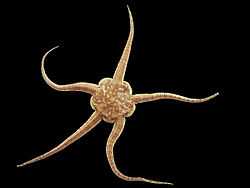Ophiurida
| Ophiuroidea Temporal range: Devonian - present [1] | |
|---|---|
 | |
| Ophiura ophiura | |
| Scientific classification | |
| Kingdom: | Animalia |
| Phylum: | Echinodermata |
| Subphylum: | Eleutherozoa |
| Superclass: | Cryptosyringida |
| Class: | Ophiuroidea |
| Order: | Ophiurida Müller and Troschel, 1840 |
| Suborders | |
|
See text. | |
- Not to be confused with Ophiuroidea, the class that contains Ophiurida.
The Ophiurida are an order of echinoderms within the class Ophiuroidea. It includes the vast majority of living brittle stars.
Characteristics
The upper surface of the disk of Ophiurida is covered with scales.[2] They have bursae for respiration and excretion, and dorsal and ventral arm shields are present and usually well developed. Arms are unbranched and incapable of coiling vertically. Most are five-armed, some with 4 or 6 arms as an abnormality, but others properly bear six or seven arms. The madreporite is on the oral surface. The digestive glands are entirely within the central disc.[3] They move their arms side to side by means of ball-and-socket joints. Tropical species tend to contrast color from the environment, but most others prefer to blend in. These biochromes do not include echinochromes. Some species exhibit luminescence, but only for short periods when stimulated, generally on the bases of the arm spines.
Systematics and phylogeny
There is currently no consensus as to the subdivision of the Ophiurida. The order has been divided into the following suborders and infraorders [4]
- Ophiomyxina
- Ophiurina
- Hemieuryalina
- Chilophiurina
- Gnathophiurina
- Ophiodermatina
- Ophiolepidina
Another classification scheme divides it into the following suborders:[5]
- Chilophiurina Matsumoto, 1915
- Laemophiurina Matsumoto, 1915
- Ophiothricidae Ljungman, 1867 (= Ophiotrichidae)
- Ophiurina Müller & Troschel, 1840
Another classification scheme divides it as:[6]
- Chilophiurina
- Laemophiurina
- Gnathophiurina
Ecology
Ophiurida have a world-wide distribution range and are found in oceans in different depths. Most of them are herbivores or detritus feeders.
References
- ↑ E.Clarkson, E.N.K. Clarkson, Invertebrate Palaeontology and Evolution. Wiley-Blackwell; 4.ed. (1998)
- ↑ Grzimek's Animal Life Encyclopedia, vol 1, Gale Cengage 2003
- ↑ R.C.Brusca, G.J.Brusca. Invertebrates. Sinauer Associates, 2 ed.(2003)
- ↑ Smith, A.B.; Paterson, G.L.J. . Ophiuroid phylogeny and higher taxonomy: morphological, molecular and palaeontological perspectives. Zool. J. Linn. Soc. 114 (1995)
- ↑ European Register of Marine Species
- ↑ Mikko's Phylogeny Archive